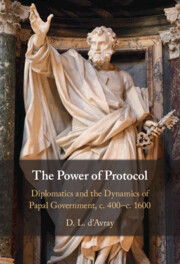183 results
2 - The History of Papal Diplomatics
-
- Book:
- The Power of Protocol
- Published online:
- 20 July 2023
- Print publication:
- 10 August 2023, pp 14-37
-
- Chapter
- Export citation
Preface
-
- Book:
- The Power of Protocol
- Published online:
- 20 July 2023
- Print publication:
- 10 August 2023, pp xi-xii
-
- Chapter
- Export citation
Copyright page
-
- Book:
- The Power of Protocol
- Published online:
- 20 July 2023
- Print publication:
- 10 August 2023, pp iv-iv
-
- Chapter
- Export citation
Plates
-
- Book:
- The Power of Protocol
- Published online:
- 20 July 2023
- Print publication:
- 10 August 2023, pp 233-238
-
- Chapter
- Export citation
Abbreviations
-
- Book:
- The Power of Protocol
- Published online:
- 20 July 2023
- Print publication:
- 10 August 2023, pp x-x
-
- Chapter
- Export citation
4 - The Religious Governance of the Latin World, 1150–1378
-
- Book:
- The Power of Protocol
- Published online:
- 20 July 2023
- Print publication:
- 10 August 2023, pp 77-136
-
- Chapter
- Export citation
3 - Papal Documents, c. 400–c. 1150
-
- Book:
- The Power of Protocol
- Published online:
- 20 July 2023
- Print publication:
- 10 August 2023, pp 38-76
-
- Chapter
- Export citation
Acknowledgements
-
- Book:
- The Power of Protocol
- Published online:
- 20 July 2023
- Print publication:
- 10 August 2023, pp ix-ix
-
- Chapter
- Export citation
Index
-
- Book:
- The Power of Protocol
- Published online:
- 20 July 2023
- Print publication:
- 10 August 2023, pp 260-266
-
- Chapter
- Export citation
6 - Retrospective: Some Long-Term Continuities
-
- Book:
- The Power of Protocol
- Published online:
- 20 July 2023
- Print publication:
- 10 August 2023, pp 186-195
-
- Chapter
- Export citation
Reproductions
-
- Book:
- The Power of Protocol
- Published online:
- 20 July 2023
- Print publication:
- 10 August 2023, pp 231-232
-
- Chapter
- Export citation
Plates
-
- Book:
- The Power of Protocol
- Published online:
- 20 July 2023
- Print publication:
- 10 August 2023, pp viii-viii
-
- Chapter
- Export citation
1 - Introduction
-
- Book:
- The Power of Protocol
- Published online:
- 20 July 2023
- Print publication:
- 10 August 2023, pp 1-13
-
- Chapter
- Export citation
Bibliography
-
- Book:
- The Power of Protocol
- Published online:
- 20 July 2023
- Print publication:
- 10 August 2023, pp 239-259
-
- Chapter
- Export citation
Dedication
-
- Book:
- The Power of Protocol
- Published online:
- 20 July 2023
- Print publication:
- 10 August 2023, pp v-vi
-
- Chapter
- Export citation
Transcriptions
-
- Book:
- The Power of Protocol
- Published online:
- 20 July 2023
- Print publication:
- 10 August 2023, pp 196-230
-
- Chapter
- Export citation
5 - From Schism to Counter-Reformation, c. 1378–c. 1600
-
- Book:
- The Power of Protocol
- Published online:
- 20 July 2023
- Print publication:
- 10 August 2023, pp 137-185
-
- Chapter
- Export citation
Contents
-
- Book:
- The Power of Protocol
- Published online:
- 20 July 2023
- Print publication:
- 10 August 2023, pp vii-vii
-
- Chapter
- Export citation

The Power of Protocol
- Diplomatics and the Dynamics of Papal Government, c. 400 – c.1600
-
- Published online:
- 20 July 2023
- Print publication:
- 10 August 2023
7 - Clerical Status and Monks
-
- Book:
- Papal Jurisprudence, 385–1234
- Published online:
- 10 March 2022
- Print publication:
- 17 March 2022, pp 74-86
-
- Chapter
- Export citation



